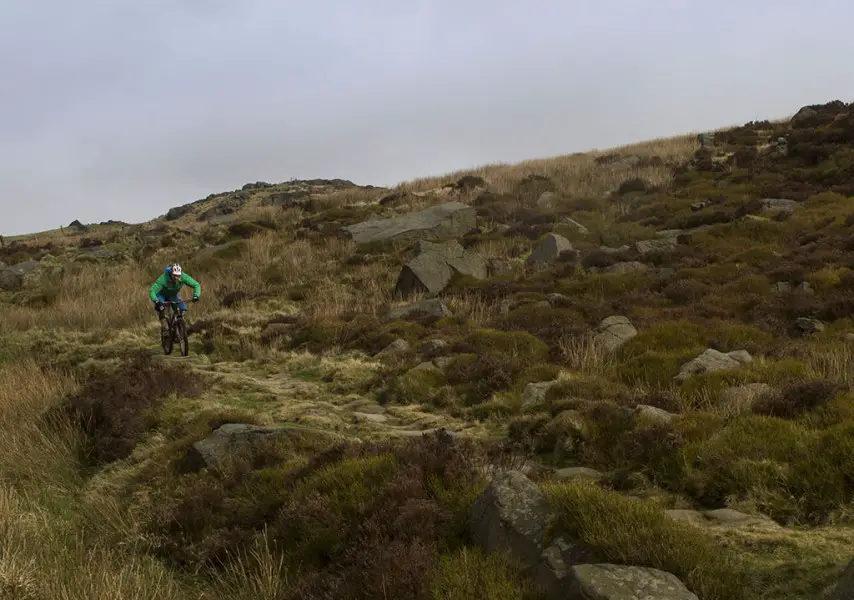The ‘66’ in the name reflects the fact that this Yeti offers 6in of travel and has 26in wheels. The ‘C’ denotes the carbon frame.
Our test bike came with a suitably high-end build kit, which helped keep the weight low for a bike offering 152mm of rear wheel travel with 160mm up front.
The frame is said to be 1.5lb lighter than the (£1,999) aluminium version, and you could go lighter if you threw even more money at it, but this build seems to be an ideal compromise between low weight and sensible durability.
The smooth silky lines of the high modulus carbon mainframe and swingarm are complemented by the clutter-free aesthetics of the eccentric pivot above the bottom bracket shell. A dual link rocker compresses Fox’s CTD Kashima-coated shock and the ride feel of the suspension (and wheel axle path) shifts constantly, with the eccentric pivot acting as an extra micro-link as the shock compresses and extends. Yeti calls this Switch technology.
The vulnerable surfaces of the frame are shielded from chain slap damage on the swingarm and flying rock damage underneath the down tube. Cable routing is external on the mainframe (including guides for a dropper post) and in the swingarm to the rear gear. There’s a single set of bottle cage bosses under the down tube, so it’s a hydration pack bike really.
Our test bike had a 1 x 11 SRAM X01 drivetrain, but there’s a plate for a front mech and removable ISCG chain guide tabs can be added to the press-fit bottom bracket. Wheels are Stan’s ZTR Crests with Maxxis Ardent EXO treads, 2.4in up front, 2.25in out back. Brakes are Avid Elixir 9s, the stem and seatpost are from Thomson, bars are 760mm carbon Easton Havens, the saddle and grips are Yeti branded and the 150mm Fox Float 34 CTD Kashima fork is an ideal match for the shock.
Trail Notes.
The SB66C is one of the few bikes that’s been raced to a podium position at international level in downhill, 4X and enduro events.
It also happens to be a superb trail bike which bowls along with a tight and lively trail feel that initially seems to have much more in common with a shorter travel bike. But, and it’s a fairly big but, when the going gets rough it also has lots of ability in reserve. We never really felt as though we reached its full potential during the test period, but we loved almost every minute of not reaching that potential.
The feel of the eccentric pivot configuration is unusual but appealing. Its initial up and back axle swing creates some barely noticeable chain growth, making for superbly pert initial acceleration on any terrain. On bumpy trails, when you unweight the bike to ghost-jump bumps, the anti-squat aspect of the back end seems to gain a tiny amount of extra forward propulsion. When things start to get really rowdy the eccentric pivot swings into the up and over part of its arc, helping the shock to swallow the big stuff before returning to its initially rearward axle path in order to muffle the square edges of smaller stuff.
Overall, this creates a ride persona that’s generally relaxed and controlled, but the 26in wheels undoubtedly create a choppier, more animated ride than that found on a long travel 29in bike. Some riders will love this, some won’t. Either way, it creates an exciting and inspiring ride on all types of terrain and the ease of handling and warp speed control are never in doubt. On the contrary, the SB66C seems to egg you on. Its limits are mainly defined by your nerve (and tyre choice.)
The tight back end and relatively low weight combine to make climbing pretty straightforward too. We spent most of the test period with both the fork and shock in ‘Trail’ mode, only using ‘Descend’ on high-speed descents of a long technical nature and never really feeling the need for the ‘Climb’ position. At first we set both the fork and shock at around 30% sag. That seemed ideal on the fork but we ended up settling on 25% for the shock, as at 30% it would reach full travel frequently on most rides, and that would often cause pedal strikes on compression dips.
The Yeti SB66C is a bike that responds well to aggressive pedalling, so it feels at its best with a fair amount of shock compression in reserve for accidental, clumsy or ‘big’ moves. Of its type, it’s one of the very best out there, but with an alloy 27.5in SB75 already out, how long will this carbon Yeti keep its smaller wheels?
- Frame // High modulus carbon, Fox Float CTD Kashima 152mm shock
- Fork // Fox Float 34 CTD 150mm Kashima
- Hubs // Stan’s 3.30 32 spoke, thru-axles
- Rims // Stan’s ZTR Crest
- Tyres // Maxxis Ardent EXO 2.4in front, 2.25in rear
- Chainset // SRAM X1 32t
- Front Mech // None
- Rear Mech // SRAM X0
- Shifters // SRAM X1 1×11
- Brakes // Avid Elixir 9 Trail
- Stem // Thomson
- Bars // Easton Haven Carbon 760mm
- Grips // Yeti Lock-on
- Seatpost // Thomson Inline
- Saddle // Yeti
- Size Tested // Medium
- Sizes Available // S, M, L, XL
- Weight // 26.5lb without pedals
Review Info
| Brand: | Yeti |
| Product: | SB66C |
| From: | Silverfish, silverfish.uk.com |
| Price: | £5,384.00 as tested (frame only £2,599.00) |
| Tested: | by Steve Worland for |



